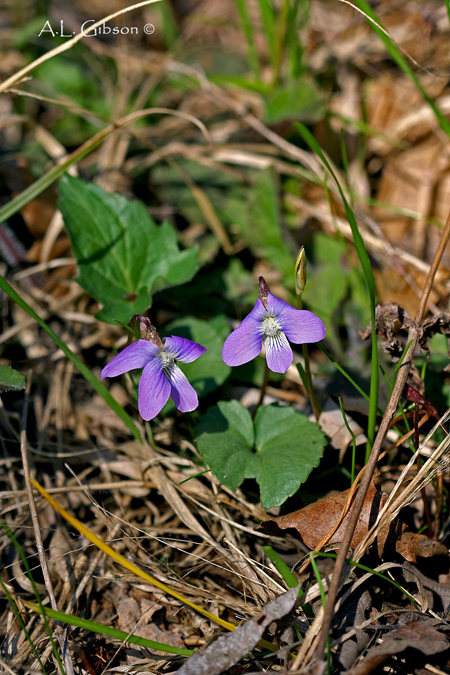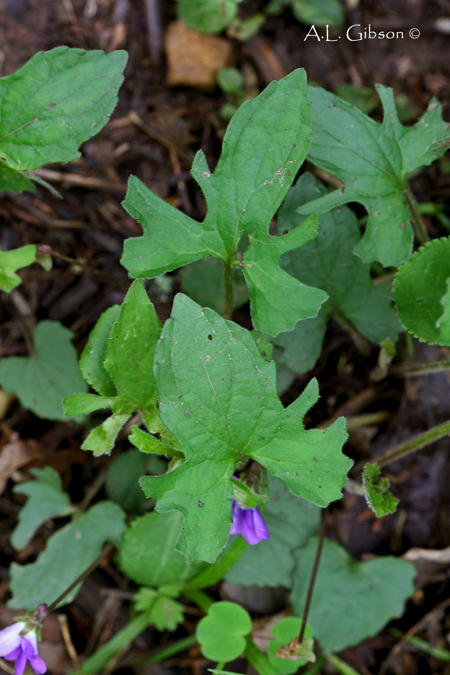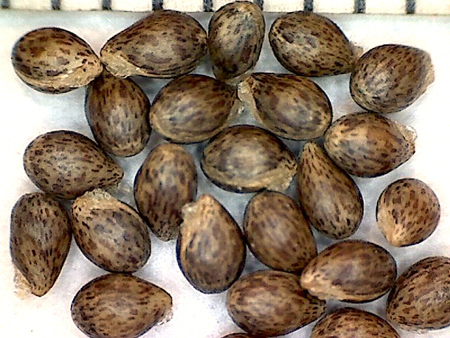Viola palmata L. var. triloba (Schwein.) Ging.
Common names:
Northern Three-lobed Violet
Synonyms:
Viola palmata L. var. triloba (Schwein.) Ging., in DC., Prodr. 1: 291-292. 1824; Viola triloba Schwein., Amer. J. Sci. 5: 57. 1822. TYPE. "rich woodland and meadows". Type: USA, [North] Carol.[ina], Salem, [no date], [L. D. von Schweinitz s.n.] (lectotype incorrectly designated as holotype by Landon McKinney, Sida, Bot. Misc. 7: 12. 1992: PH00029298!). [von Schweinitz cited no type and no collections. The Schweinitz specimen at PH bears no indication by the author that the specimen is a type. However, it appears to be the only specimen of its kind with von Schweinitz's label. Both Landon McKinney and Nir Gil-ad identified this sheet as holotype, but it cannot be that. McKinney was first to designate the sheet, and the lectotypification is corrected here.]
Viola congener Leconte, Ann. Lyceum Nat. Hist. New York 2: 140. 1828 ["1826"]
Viola palmata L. f. striata O.R.Willis, Bull. Torrey Bot. Club 16: 278. 1889
Viola ornithodes Greene, Leafl. bot. observ. 1(4): 218. 1903-1906
Viola vespertilionis Greene, Leafl. bot. observ. 1(4): 217. 1903-1906
Viola triloba Schwein. f. albida Steyerm., Rhodora 54: 256. 1952
Viola triloba Schwein. f. annjoae Creutz, Wild Fl. 35: 9, fig. 1, 4-7. 1959
Description:
Foliage and peduncles moderately to densely hirsute, green, margins of leaf blades ciliate, peduncles nearly glabrous or sparsely hirsute; larger leaf blades shallowly to moderately pedately divided into 3 or 5 lobes, central lobe of terminal primary division elliptical to ovate or broadly triangular, lateral divisions undivided or shallowly cleft, sinuses between primary divisions not reaching more than 1/2 (2/3) the distance to the petiole summit, the longest axis of the lateral primary divisions or the intermediary lobe nearest the terminal primary division < 1/2 the length of the midrib; calyx ciliate; lowest sepals oblong-ovate to ovate, obtuse to rounded at apex; cleistogamous capsule heavily purple-spotted or blotched, on an initially prostrate peduncle arching upward abruptly just prior to dehiscence. Other features as in V. palmata sensu lato.
Ecology:
Drier to dry somewhat acidic sandy or clayey loam soils in dry to dry-mesic oak woodlands, often on slopes or drier terraces above streams, rivers and lakes.
Distribution:
Ne. North America southward into the Appalachian Mtns and associated uplands, mostly absent from Lower Piedmont, se. Atlantic Coastal Plain and the Gulf states, the s. limit in the "Deep South" unclear; MA and s. VT to s. MI and IL, south to SC, c. LA and se. OK.
Rarity:
State listed in NH; and ME, RI, and VT as V. palmata.
Phenology:
Phenology presumably the same as V. palmata sensu lato.
Affinities:
This species belongs to the Acaulescent Blue Violet lineage, sect. Nosphinium W.Becker, subsect. Boreali-Americanae (W.Becker) Gil-ad, in the Palmata species group.
Hybrids:
Hybridizes with V. affinis (Brainerd 1924), V. brittoniana (Brainerd 1906b, 1924), V. communis [or possibly V. "sororia glabrous" or V. "sororia hirsutula-like"] (Brainerd 1912, 1924), V. cucullata (Brainerd 1906b, 1913c, 1924, House 1924, Haines et al. 2011), V. fimbriatula (Brainerd 1906b, 1924, Haines et al. 2011), V. hirsutula (Brainerd 1906b, 1912, 1924, House 1924), V. latiuscula (Brainerd 1912, 1924, House 1924), V. sagittata (Brainerd 1906b, 1913c, 1924, House 1924), V. sororia sensu stricto (Greene 1989c, Brainerd 1912, 1924, House 1924, Scoggan 1978, Haines et al. 2011, Ballard 2013), V. stoneana (Brainerd 1910b, 1912, 1924), and V. subsinuata (Pollard 1902, Brainerd 1912, 1924, Haines et al. 2011). Brainerd reported that these exhibit intermediate or recombinant characteristics of foliage, chasmogamous flowers, cleistogamous capsules and seeds (where these did not abort). All the hybrids fail to reproduce by chasmogamous means. Some hybrids produce abortive cleistogamous flowers or capsules, while others produce very few viable seeds. The hybrid with V. sororia is subfertile, with up to 1/3 of its ovules fertilized.
Comments:
Specimens presently identified as var. triloba in the main range of var. palmata may, at least in part, represent de novo hybrids involving var. palmata with V. sororia or other species. For more information, see comments under V. palmata sensu lato.
Literature Cited:
Ballard Jr., H. E. 2013. Violaceae. In Yatskievych, G., Flora of Missouri. Missouri Botanical Garden Press, St. Louis, MO. 1218-1243.
Brainerd, E. 1906b. Hybridism in the genus Viola,-II. Rhodora 8: 6-10.
Brainerd, E. 1910b. The evolution of new forms in Viola through hybridism. American Naturalist 44: 229-236.
Brainerd, E. 1912. Violet hybrids between species of the palmata group. Bulletin of the Torrey Botanical Club 39: 85-97.
Brainerd, E. 1913c. Notes on new or rare violets of northeastern America. Rhodora 15: 112–115.
Brainerd, E. 1924. The natural violet hybrids of North America. Vermont Agricultural Experiment Station Bulletin 239: 1-205.
Greene, E. L. 1898d. Some Canadian violets. Pittonia 3: 333-338.
Haines, A., E. Farnsworth, and G. Morrison. 2011. Violaceae. In Flora Novae Angliae. Yale University Press, New Haven, CT. 873-886.
House, H. D. 1924. Annotated list of the ferns and flowering plants of New York state. Family 83 Violaceae. New York State Museum Bulletin 254: 499-512.
Pollard, C. L. 1902. A new violet from New Jersey. Torreya 2(2): 24-25.
Scoggan, H. J. 1978. Violaceae. In Flora of Canada, Part 3–Dicotyledoneae (Saururaceae to Violaceae). National Museums of Canada. Ottawa, Canada. 1103-1115.

Chasmogamous flowering habit by Andrew Gibson, "Buckeye Botanist" website

Leaves by Andrew Gibson, "Buckeye Botanist" website

Chasmogamous flower front view by Andrew Gibson, "Buckeye Botanist" website

Seeds from herbarium specimen: Transplanted from OH, Athens Co., Sells Park, H. Ballard 15-055Z (BHO)

Map of widespread varieties of V. palmata by Harvey Ballard, adapted from Russell (1965)